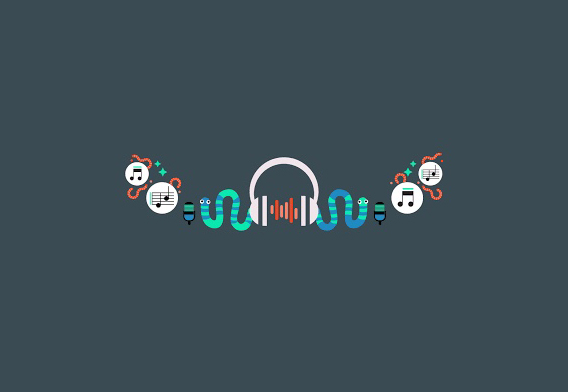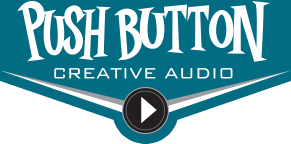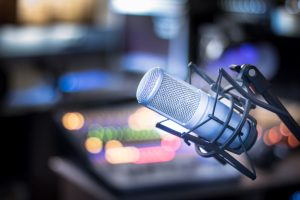
Why Do Radio Jingles Work? According to Science
So, you’re thinking of using a radio jingle in your newest ad campaign. Here’s some concrete evidence that a radio jingle is exactly what you need to get your brand out there and stuck in consumers’ heads. Music and advertising are a historic power duo. Merchants in the crowded marketplaces of London in the 1500s would sing to cut through the noise of the space and attract customers. Their songs may not have been as catchy as our modern-day radio jingles, but the concept of them is that long-standing. Today, we know a lot more about exactly why radio jingles work than our friends did back then. That earworm of a radio jingle that’s been running through your head since you got to work this morning is doing exactly what it’s meant to, and it’s all thanks to a little thing called “involuntary musical imagery” (INMI). There’s a lot of neuroscience that goes into this, and while I could tell you about how INMI is related to the default mode network in the brain, which is a function of the prefrontal, posterior cingulate, and parahippocampal cortices, I’ll condense what you need to know in layman’s terms: when you hear a familiar piece of music, your brain floods itself with memories related to that tune. This is perfect for advertising your brand.
Radio jingles are the only advertising method that will get you hours of free airtime in your listeners’ own brains. They’ll get stuck in their heads, and when they hear bits of them again, they’ll instantly remember your ad and what you were telling them in it. It’s no surprise that a great radio jingle will get stuck in your head, but what does that fact mean for your brand? A study published in 2018 by Neurosight, which analyzed over 150 ads, determined which ones were most strongly correlated with long-term memory encoding. “This study reinforced the idea that music in TV ads becomes more memorable when it drives the action of the ad, such as when the lyrics or tempo matches what is happening on screen.” In other, more radio-centric words, the radio jingles that you feature in your ads create a brand in the brain of your customers. Radio jingles are highly effective tools to give your advertisement a perfect sense of your brand. Want to seem cool and modern? Choose a modern pop-rock style for your ad. Get a great, jazzy, big-band tune for a “classic” feel for your brand. Don’t just take it from us: radio jingles work. If you’re looking to build your brand and be heard (again and again and again), they’re just what you need.
Why You Need A Radio Jingle for Your Brand
Brand Awareness
Radio jingles have a simplistic way of creating brand awareness. When people hear it, they associate it with your brand. Once a consumer has heard your radio jingle and they see an ad for your business or product, they’ll have the song to associate it with. No matter if listeners hate or love your radio jingle, they will remember it. Then, the consumer builds trust with your brand and is more likely to choose it over a competitor.
Memory
The number one reason companies create a radio jingle is because consumers will remember it. Creating a special and entertaining song will help your brand stand out against competitors. The most successful radio jingles are the ones where companies understand their singularity and translate it into a catchy rhythm. Keep it simple. Use your companies’ number or name as part of the jingle. The simpler it is, the easier it is to remember. Also, keep repeating it. Put your radio jingle on repeat throughout your campaign and consumers will be sure to remember it. Give listeners an uncomplicated song to sing and every time they see an ad from your brand, they’ll already feel associated with it.
Radio Jingles – Political Benefits
Let’s make political jingles great again! No one wants to talk about politics anymore. Well, unless it’s in the form of a Facebook hate comment. It’s become a chore to vote, and it’s become a huge dividing buzzkill in our country. The political ads on TV today rarely sing the praises of the candidate in question – opting to smear the opposing side with a slew of accusations instead. Whatever happened to the light-hearted jingles in political ads, akin to the Eisenhower, Johnson, Nixon, and Kennedy campaigns?
Bring Back Political Ads
It has been argued that no one buys the “innocent and naïve” style of jingles anymore. But they were huge in the postwar era when there was growth in the economy and major consumption. It was common to see a candidate use a jingle for their political ads. So what happened? The new generation of consumers and voters thought jingles were “uncool” and “old-fashioned.” So they fizzled out.
Campaign. Jingle. Vote. Repeat.
Okay, so jingles aren’t “cool.” (Actually, they are, we’ll get to that in a minute) but they are effective. No one can deny their power. They always have been and always will be effective, because our brains are wired to remember melodies and repetition. Memory recall is extremely important for political ads – why else would candidates place signs with their names down every road and on every neighbor’s lawn? Those signs say nothing about their platform. Nothing is there to persuade you to vote for them. But it does say their name. And the more that name gets engrained in a voter’s brain, the more likely they are to fill in the bubble next to it. That is the power of political ads.
Jingles for Marketing
People today still remember the “Like Ike” and “Kennedy, Kennedy” jingles among many others. They were hugely successful and a major instrument in helping both candidates secure their presidencies. We think jingles should make a comeback in political ads – and Forbes agrees that jingles are going to be back on the rise. 30 under 30 CEO Jordan Passman states, “Though the jingle has proved to be such a strong marketing tool, it’s much more scarce in today’s market than it was in the past. Despite the drastic drop in jingles in today’s market, I predict that we’ll see a powerful resurgence in the near future. The brands that continue to harness the art of the jingle, such as McDonald’s, are thriving.”
Jingles in political ads don’t have to sound cheesy or outdated. They can be cool. They can be revamped with a modern style, similar to what you would hear on the radio today. Wouldn’t it be a lot more fun to see politicians singing instead of slandering? If done correctly and tastefully, incorporating a jingle into your political ads can be a smart move. Get the whole town singing your name, and you might just win the game.
Choosing the Right Music Genre for Your Radio Jingle
The thought of radio jingles may conjure up a very specific sound in your brain – a dated, peppy, “I’d like to give the world a Coke” sound from yesteryear. If that’s the case, I have some great news for you: your radio jingles don’t have to sound anything like that in 2023. You’ve got a million options, so what should your modern jingle sound like? Picking the best music genre for your radio jingles is an important process, and here’s what you need to know to get the best end product.
The Production Process
Producers of television commercials know that hours of thought and research go into deciding each visual detail, from the social connotations tied to the outfits of the actors to the color psychology of the background imagery. The same scientific decision-making can be applied to radio jingles.
Identifying Your Target Market
The first step? It’s the first thing to decide when planning any part of an ad: Who is this for? Who will be listening? Who needs to be listening? Running into the production process without pinpointing your target demographic could leave you with a final product that gets you the wrong kind of business (or, no business at all).
Utilize Data & Metrics
Before you start compiling the instruments and voice talent that make up your future radio jingles, you have to decide what elements your customers want to hear. Powerhouse music companies like Live Nation have started to step into the advertising game, offering advertisers data on whose concert tickets their target customers are buying. Advertisers take this data, analyze what their target demos’ preferred music tastes are, and employ that genre of music in their TV spots and radio jingles. Even if your advertising budget doesn’t quite allow room for one-on-one communications with Live Nation, similar data can be found for free online. Spotify’s Newsroom provides detailed insights into how they create playlists, focusing on the latest music of 2023. This is a great tool for understanding what music is popular now, as it shows both global and local music trends. Through Spotify’s playlists, you can easily see what music is currently popular in different communities worldwide.
Design Your Music
Selecting the right music genre for your radio jingles can make or break the ad. No other medium of advertising is so dependent on music choice–it’s a radio jingle. You’re writing music to go alongside today’s hits and compete with them for listeners’ attention. There’s a lot of work that goes into picking the right genre for your radio jingles, but it’s worth the energy.
What Separates a Commercial Jingle and a Pop Song?
The process of making a club hit and the perfect commercial jingle aren’t that different. Both require knowledge about timing and having an ear for catchiness. Both are made by professional composers and songwriters. Both are very likely to get stuck in your head for years to come. And guess what else? Barry Manilow made commercial jingles before he ever made popular music.
The difference is this: commercial jingles are selling a brand and product or service directly to the listener–Kit Kat bars, insurance, a phone number to call after spilling something on your carpet. Popular music sells the artist’s brand and an identifier for the listener. A pop song can be incorporated into the listeners’ identity, even though that identifier is shared by millions of others.
This theory is backed up by the recent trend of popular songs becoming theme songs for commercials. Applause by Lady Gaga being used to back up Kia’s hamsters, Sia’s Move Your Body plays throughout a Lexus commercial, and much more than you may have noticed. Companies are using popular music the same way they would use a commercial jingle, but that’s where the similarities end.
A commercial jingle is incredibly useful when you need someone to remember something as they would remember a song. Stanley Steamer’s jingle gets you to remember their name, number, and service—meanwhile, all Applause may have you remember is hamsters or possibly just Lady Gaga herself. And if you don’t like the song…then what? You’ll have a negative connotation with the ad and the brand. A commercial jingle focuses the consumers’ memory on the company’s brand alone, rather than splitting it with the artist’s brand.
M&M’s are blurring the line even further by commissioning Aloe Blacc and Zedd to update the M&M’s jingle Candyman, which is both a popular commercial jingle and a popular song played on the radio.
Commercial jingles and popular music are very similar in the way they are made, but very different in the way they perform in the advertising landscape.
A Look in a Jingle Writer’s Day
As jingle writers, we have a detailed process for every client. Each jingle starts with a brief. A creative brief is the research put in your company so that each jingle is guaranteed to be unique and on point with your brand and goals. History, brand voice, competitor research—it’s important the brief covers it all, so your jingle is as true to your company as possible.
When the first jingle writers scripted the lyrics for the “Wheaties Quartet,” they had no idea just how successful it would be. They sang their praises to the General Mills cereal on Christmas Eve, 1926, creating the first modern “jingle.” The song was such a hit, that it sparked the sale of Wheaties country-wide and prevented them from being discontinued!
How do jingle writers make a tune so catchy? Rhyme, repetition, and simple language is the key. The goal is to inspire brand recognition and recall. All good jingle writers know that a catchy tune comes down to science and your brain. The phonological loop consists of your inner ear remembering sounds and your articulatory rehearsal system repeating back loops in your brain. In layman’s terms—the easier it is to remember, the more successful it will be.
Our jingle writers comb over every word meticulously to create the perfect rhythm and rhyme that showcases your brand’s personality. Since jingles are short, it’s important to get it right in such few words. But that doesn’t mean we get it right the first time—jingle writers put in work to write, edit, rewrite, and perfect a quality tune. The time put into each jingle shows. Once everything has been scripted, approved, and produced, it’s ready to rock on the radio and you have a jingle your brand can be proud of.
Behind the Scenes of Radio Jingle Production
We know, we know. Our jobs seem super glamorous. Jet-setting from one side of Orlando to the other, masterfully bringing together words and music in the name of top-tier radio jingle production. Yes, it’s as incredible as it sounds. You’re too kind.
Today, we’re here to demystify radio jingle production. It can be a lot of hard work across teams, offices, and even state lines, but the end product is so awesome, that it’s always worth it. So, where does radio jingle production take off?
First, production teams meet with the client to learn about their vision. It’s their jingle, anyway – we’re just singing in it. An initial creative brief meeting can last for five minutes or fifty. It all depends on the client. Do they have a crystal-clear image (or, we suppose, a soundbite) or their dream jingle? Or do we need to get the creative thoughts flowing as a team?
Once everyone’s on the same page, pre-production begins. Copywriters get to work happily writing the phrase you won’t be able to get out of your head for the next year. In radio jingle production, a copy is more than just words on a page – writers have to consider genre, rhyming patterns, and more in their work.
The project then goes into the hands of some awesome, wizard-level musicians. Their melodies and hooks turn words into a memorable jingle. This step is what puts great radio jingle production over the top.
Finally, the project is mixed, mastered, and tied up with a bow, and sent off to the client. Does radio jingle production sound like a lot of work? That’s because it is. Thankfully, awesome production teams, like the one at Push Button Productions (but we’re biased), have easy Jingle Packages that make radio jingle production stress-free for you. Shoot us an email or a call – we’ll guide you every step of the way.
The “Jingle Strategy”
What you don’t see behind the creation of every advertisement is the strategy. Good or bad, a well thought out strategy will define the success of an ad.
But we don’t create just any kind of ad; we create audio. And we’re good at it, too. So we can say with certainty that our favorite type of advertisement is the classic radio jingle. Despite changing technology, culture and the momentous switch to social media, a classic radio jingle has proved successful in this fast-paced informational world. So to share a piece or success, we’re here to describe a near-perfect “jingle strategy” and how you can use it in your audio.
Find Your Brand, Find Your Voice
This one is pretty obvious but more overlooked than you might think. If you did step one correctly, you know through and through what you’re writing about and why it needs to sound a certain way. Answering these questions will explain why a surf shop should remind you of a Bill and Ted movie, or why a slow ballad will sell the idea of a romantic getaway cruise a lot better than quick-beating Caribbean drums. But don’t trash all of your island-themed audio just yet, we meant that the Caribbean drums are best used for family cruises, more adventurous, less rose petals on a bed sort of thing.
Write the Damn Song
Lyrics are essential, they’re what get stuck in your head as you go to bed. The music is the base, it’s what you hum carrying your groceries to your car. Don’t rely on one or the other, keep them balanced. Decide on a length, write your music first using your research and your brand’s voice. Then create an actual voice by writing effective and clear language. We’re talking about a radio ad or the 5 to 30 seconds before a YouTube video starts, you aren’t in the business of being visually appealing and something they’re going to want to go back to time and time again (unless you can make something super funny in that case go for it). You’re creating memorable audio, something they’ll recognize when they hear it again, so it hopefully gets caught in their head and will create brand recognition for your product when the time comes that they need a quick lunch or want to try the new Korean BBQ joint.
6 Fun (Research Proven) Facts About Radio Jingles
- Jingles work, flat out. 89% of respondents claimed radio jingles are an effective tool for advertising. 63% stated it was because radio jingles have a strong memory-creating effect. 23% responded they believe radio jingles are effective because they attract more attention than other kinds of ads. And 15% believed jingles create a “nice” and “pleasant” atmosphere regarding the brand.
- Slogans and jingles are a match made in radio heaven. Combining your slogan with a jingle leads to a higher probability of memory recall among consumers.
- Radio jingles define your brand and clear up any confusion among the competition. Brand confusion occurred nearly twice as often with slogans alone than with radio jingles (for example, participants confused Volvo with BMW).
- Radio jingles make them remember you when they’re deciding who to call. 74% of the respondents reported that jingles helped them remember the name of a product or brand.
- Women remember radio jingles that are targeted toward women better than men, and men remember radio jingles that are targeted toward men better than women. Duh, that’s obvious. But here’s the interesting part – there was an outlier. Only 9% of women recognized a jingle by Garnier (a female shampoo brand) whereas 20% of men could recall hearing it. This is most likely because Garnier chose a riff by a young rock band with a predominantly male fan base. The study suggests Garnier should have selected a different song if they wanted to appeal to women. Always take your audience into consideration when picking the tune for your jingle!
- The Coca-Cola jingle was the most widely recognized radio jingle in the study.
Ask for Help
Hopefully, our advice has brought you some clarity into creating the perfect “jingle strategy” and brings you one step closer to creating the perfect jingle.
We understand that not everyone is a jingle-writing pro. It takes a lot of research, talent, and experience to turn an otherwise generic-sounding tune into a fine-crafted piece of audio that will be associated with your brand forever.
However, we are jingle-writing pros. So if you’re interested in a jingle, don’t hesitate to call us at 888-494-7874 (PUSH) you want to see the difference between a good jingle and a bad one, download our special report 8 Reasons Why Most Jingles Suck.
Sources:
https://www.theatlantic.com/business/archive/2016/08/what-killed-the-jingle/497291/
https://www.kqed.org/lowdown/3955/ten-of-the-best-presidential-campaign-commercials-of-all-time










